Title: Army Air Force Captain, World War II, Prisoner of War
Birthdate: June 27, 1918
Death Date: June 18, 1946
Plot Location: Section 140, Lot 13
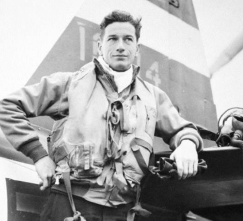
Frank was born in the little residential borough of Sharon Hill in southeastern Delaware County. He was born to Walter and Sara, the fifth of eight children, and named after his German grandfather. And he was born during the Great War, when his uncle was in France and his father was a pipefitter at the Baldwin Locomotive Works, a few miles southwest of Sharon Hill in Eddystone. During Frank’s high school years the family lived at 5829 WIllows Avenue in Philadelphia, just a short walk north of Mount Moriah Cemetery off of Cobbs Creek Parkway.
After his father passed away in 1938, Frank and his two brothers provided the income to feed 11 people in their house. It was home to Sara, her oldest son, his wife and their three preschoolers, plus Sara’s five other children. When Frank registered for the draft in 1940 he was a switchgear electrician at the big General Electric plant just south of Mount Moriah at 69th and Elmwood Ave.
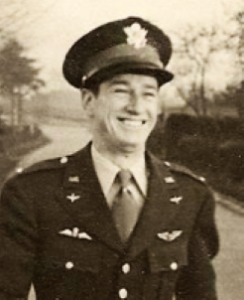 The Army recorded the official date of Frank’s enlistment as September 23, 1942, listing the place as London. According to a relative, he actually joined the Royal Canadian Air Force the previous September, before U.S. involvement in the war. He was sent to England’s Royal Air Force in one of their “Eagle Squadrons” that joined the U.S. Eighth Army Air Forces in September of 1942.
The Army recorded the official date of Frank’s enlistment as September 23, 1942, listing the place as London. According to a relative, he actually joined the Royal Canadian Air Force the previous September, before U.S. involvement in the war. He was sent to England’s Royal Air Force in one of their “Eagle Squadrons” that joined the U.S. Eighth Army Air Forces in September of 1942.
Frank was in the Fourth Fighter Group, the first 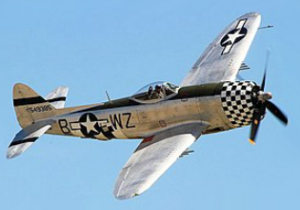 to fly combat missions over German airspace, and they flew the P-47 Thunderbolt, like the one shown here, in 1943.
to fly combat missions over German airspace, and they flew the P-47 Thunderbolt, like the one shown here, in 1943. 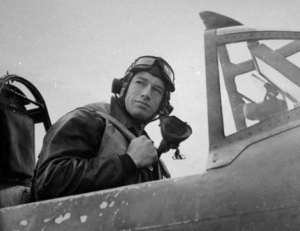 He flew 62 missions successfully until September 5, 1943. Escorting a flight of B-17 Fortresses to knock out an airfield at St. Cyr, he was shot down northwest of Paris and picked up by the French Underground. He was taken to Paris where a woman and her step-daughter hid Frank in their apartment until they could arrange passage to England via Spain. Just one week later, though, they were discovered by the Gestapo and imprisoned.
He flew 62 missions successfully until September 5, 1943. Escorting a flight of B-17 Fortresses to knock out an airfield at St. Cyr, he was shot down northwest of Paris and picked up by the French Underground. He was taken to Paris where a woman and her step-daughter hid Frank in their apartment until they could arrange passage to England via Spain. Just one week later, though, they were discovered by the Gestapo and imprisoned.
Captain Fink was eventually sent to the Stalag 7A prisoner of war camp. Fortunately there were very few deaths and more than a third of the 112,000 POWs that were there worked in farms or factories. They were liberated by General George S. Patton’s army on April 29, 1945.
“Liberated” and “repatriated” are official terms to describe the post-war POWs but after one year and 8 months of prison life, how Frank felt is unimaginable. One source reports he came home wearing the King’s Star for his service in the R.A.F. and the Distinguished Flying Cross with four oak leaf clusters. He remained in the service for another 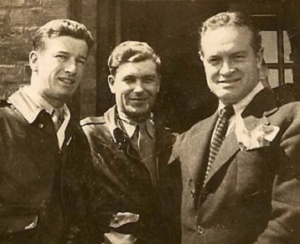 year. At some point he even had this picture taken (he’s on the left) with the famous Hollywood star and USO Ambassador, Bob Hope.
year. At some point he even had this picture taken (he’s on the left) with the famous Hollywood star and USO Ambassador, Bob Hope.
The story continues with what happened to those two female patriots who sheltered Frank in September of 1943. They were sent to Ravensbrück concentration camp, then to a camp in Czechoslovakia. On May 5, 1945 the camp surrendered to the American First Army just two hours before the two women were scheduled to be burned to death. They returned home, but a dramatic reunion would come about in an unusual way.
The younger woman’s brother was a war hero whose legs had been amputated in Algiers and was admitted to the Philadelphia Naval Hospital for further treatment. The French Naval Ministry allowed them to come join him here in October, 1945, and they immediately began inquiring about “a Captain Finch” who had stayed with them. Finally, in mid-February the War Department identified him as Captain Fink, serving at that time as an Army flight instructor in Georgia. 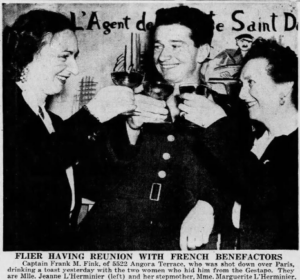
He was told about the two visitors and flew home to Philadelphia on a seven-day leave, only one week before they were to return to France. A newspaper covered the story and captured this photo, saying they met at a French restaurant at 16th and Walnut Streets, “to talk over, in halting French, the days of suspense and tragedy in Paris.”
From the pit of a prison camp to happy reunions at home, Frank’s young life then met an abrupt end. That June he was on a solo test flight at night out of the Army Air Depot near Harrisburg when his plane crashed into the side of Blue Mountain, about 50 miles west of Harrisburg, killing him instantly.
Finding him wasn’t easy until a clue came from someone who said they had heard an airplane engine sputter, then stop. Because of the remote location, it took over a week to recover the remains.  A rescue worker said if the plane had only been able to climb 50 feet higher it would have cleared the top of the mountain. The never-married 27-year-old hero from West Philly High, nicknamed “Buster” by his siblings, was buried in his parents’ plot.
A rescue worker said if the plane had only been able to climb 50 feet higher it would have cleared the top of the mountain. The never-married 27-year-old hero from West Philly High, nicknamed “Buster” by his siblings, was buried in his parents’ plot.
In 1985 the Prisoner of War Medal, shown here, was authorized by Congress to be awarded to recognized POWs after April 5,1917. Although long overdue, Frank’s name is on record as a deserving recipient.


Support the Friends of Mount Moriah
Help us in our mission to restore and maintain the beautiful Mount Moriah Cemetery by donating to our cause or volunteering at one of our clean-up events.

